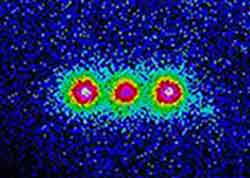This area deals with the fundamental laws and building blocks of nature and how they interact, the properties and the behavior of matter, and research into space and time and their structures.
innovations-report provides in-depth reports and articles on subjects such as astrophysics, laser technologies, nuclear, quantum, particle and solid-state physics, nanotechnologies, planetary research and findings (Mars, Venus) and developments related to the Hubble Telescope.

By surrounding fluorescent dyes with a protective silica shell, Cornell University researchers have created fluorescent nanoparticles with possible applications in displays, biological imaging, optical computing, sensors and microarrays such as DNA chips. These are all applications for which quantum dots have been used or are being considered. But the new Cornell nanoparticles offer an appealing alternative because of their greater chemical inertness and reduced cost.
“People hav

Smaller, faster computers, bullet proof t-shirts and itty-bitty robots, such are the promises of nanotechnology and the cylinder-shaped collection of carbon molecules known as nanotubes. But in order for these exciting technologies to hit the marketplace (who wouldn’t want an itty-bitty robot), scientists must understand how these miracle-molecules perform under all sorts of conditions. For, without nanoscience, there would be no nanotechnology.
In a recent study, researchers

Scientists on Huygens’ Descent Imager Spectral Radiometer (DISR) experiment have generated new views of Saturn’s giant moon, Titan.
The European Space Agency’s Huygens probe descended onto Titan on January 14, 2005. The University of Arizona-led DISR team released mosaics made from raw, unprocessed images days after Huygens landed, but they continue processing the data.
The team now has produced the first enhanced mosaic images. They used special image projection tech

A crucial step in a procedure that could enable future quantum computers to break today’s most commonly used encryption codes has been demonstrated by physicists at the U.S. Commerce Department’s National Institute of Standards and Technology (NIST).
As reported in the May 13 issue of the journal Science,* the NIST team showed that it is possible to identify repeating patterns in quantum information stored in ions (charged atoms). The NIST work used three ions as quantum bits

Observations of Titan’s atmosphere offer a unique look at how Saturn’s giant moon compares to Earth.
Titan is the only moon in the solar system with a substantial atmosphere. Like Earth, Titan’s atmosphere is primarily composed of nitrogen, but unlike Earth, one of the most abundant constituents is methane (CH4). The Huygens probe will determine if the abundance of argon exceeds that of methane. Methane, the main component in natural gas, plays a key role in the m

Scientists at The University of Nottingham have successfully levitated diamond and some of the heaviest elements, including lead and platinum.
Using liquid oxygen — the main component in many rocket fuels — to increase the buoyancy created by a specially designed superconducting magnet, they could now, in theory, levitate an object with a density 15 times larger than that of osmium, the heaviest metal known in nature.
The science behind the research could be used to devel